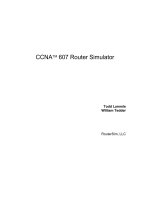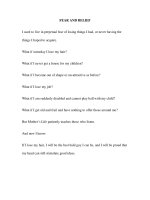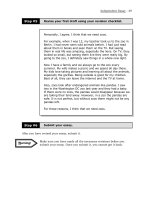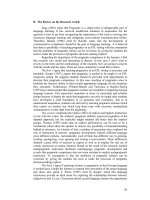Tài liệu Classes and Objects ppt
Bạn đang xem bản rút gọn của tài liệu. Xem và tải ngay bản đầy đủ của tài liệu tại đây (1.39 MB, 37 trang )
1
C++ A Beginner’s Guide by Herbert Schildt
Module8
Classes and Objects
Table of Contents
CRITICAL SKILL 8.1: The General Form of a Class 2
CRITICAL SKILL 8.2: Defining a Class and Creating Objects 2
CRITICAL SKILL 8.3: Adding Member Functions to a Class 6
Project 8-1 Creating a Help Class 9
CRITICAL SKILL 8.4: Constructors and Destructors 14
CRITICAL SKILL 8.5: Parameterized Constructors 17
CRITICAL SKILL 8.6: Inline Functions 22
CRITICAL SKILL 8.7: Arrays of Objects 31
CRITICAL SKILL 8.8: Initializing Object Arrays 32
CRITICAL SKILL 8.9: Pointers to Objects 34
Up to this point, you have been writing programs that did not use any of C++’s object-oriented
capabilities. Thus, the programs in the preceding modules reflected structured programming, not
object-oriented programming. To write object-oriented programs, you will need to use classes. The class
is C++’s basic unit of encapsulation. Classes are used to create objects. Classes and objects are so
fundamental to C++ that much of the remainder of this book is devoted to them in one way or another.
Class Fundamentals
Let’s begin by reviewing the terms class and object. A class is a template that defines the form of an
object. A class specifies both code and data. C++ uses a class specification to construct objects. Objects
are instances of a class. Thus, a class is essentially a set of plans that specify how to build an object. It is
important to be clear on one issue: a class is a logical abstraction. It is not until an object of that class
has been created that a physical representation of that class exists in memory.
When you define a class, you declare the data that it contains and the code that operates on that data.
While very simple classes might contain only code or only data, most real-world classes contain both.
2
C++ A Beginner’s Guide by Herbert Schildt
Data is contained in instance variables defined by the class, and code is contained in functions. The code
and data that constitute a class are called members of the class.
CRITICAL SKILL 8.1: The General Form of a Class
A class is created by use of the keyword class. The general form of a simple class declaration is class
class-name
{
private data and functions
public:
public data and functions
} object-list;
Here class-name specifies the name of the class. This name becomes a new type name that can be used
to create objects of the class. You can also create objects of the class by specifying them immediately
after the class declaration in object-list, but this is optional. Once a class has been declared, objects can
be created where needed.
A class can contain private as well as public members. By default, all items defined in a class are private.
This means that they can be accessed only by other members of their class, and not by any other part of
your program. This is one way encapsulation is achieved—you can tightly control access to certain items
of data by keeping them private.
To make parts of a class public (that is, accessible to other parts of your program), you must declare
them after the public keyword. All variables or functions defined after the public specifier are accessible
by other parts of your program. Typically, your program will access the private members of a class
through its public functions. Notice that the public keyword is followed by a colon.
Although there is no syntactic rule that enforces it, a well-designed class should define one and only one
logical entity. For example, a class that stores names and telephone numbers will not normally also store
information about the stock market, average rainfall, sunspot cycles, or other unrelated information.
The point here is that a well-designed class groups logically connected information. Putting unrelated
information into the same class will quickly destructure your code!
Let’s review: In C++, a class creates a new data type that can be used to create objects.
Specifically, a class creates a logical framework that defines a relationship between its members. When
you declare a variable of a class, you are creating an object. An object has physical existence and is a
specific instance of a class. That is, an object occupies memory space, but a type definition does not.
CRITICAL SKILL 8.2: Defining a Class and Creating Objects
To illustrate classes, we will be evolving a class that encapsulates information about vehicles, such as
cars, vans, and trucks. This class is called Vehicle, and it will store three items of information about a
vehicle: the number of passengers that it can carry, its fuel capacity, and its average fuel consumption
(in miles per gallon).
3
C++ A Beginner’s Guide by Herbert Schildt
The first version of Vehicle is shown here. It defines three instance variables: passengers, fuelcap, and
mpg. Notice that Vehicle does not contain any functions. Thus, it is currently a data-only class.
(Subsequent sections will add functions to it.)
The instance variables defined by Vehicle illustrate the way that instance variables are declared in
general. The general form for declaring an instance variable is shown here:
type var-name;
Here, type specifies the type of variable, and var-name is the variable’s name. Thus, you declare an
instance variable in the same way that you declare other variables. For Vehicle, the variables are
preceded by the public access specifier. As explained, this allows them to be accessed by code outside of
Vehicle.
A class definition creates a new data type. In this case, the new data type is called Vehicle. You will use
this name to declare objects of type Vehicle. Remember that a class declaration is only a type
description; it does not create an actual object. Thus, the preceding code does not cause any objects of
type Vehicle to come into existence.
To actually create a Vehicle object, simply use a declaration statement, such as the following:
Vehicle minivan; // create a Vehicle object called minivan
After this statement executes, minivan will be an instance of Vehicle. Thus, it will have “physical” reality.
Each time you create an instance of a class, you are creating an object that contains its own copy of each
instance variable defined by the class. Thus, every Vehicle object will contain its own copies of the
instance variables passengers, fuelcap, and mpg. To access these variables, you will use the dot (.)
operator. The dot operator links the name of an object with the name of a member. The general form of
the dot operator is shown here:
object.member
Thus, the object is specified on the left, and the member is put on the right. For example, to assign the
fuelcap variable of minivan the value 16, use the following statement:
minivan.fuelcap = 16;
In general, you can use the dot operator to access instance variables and call functions. Here is a
complete program that uses the Vehicle class:
4
C++ A Beginner’s Guide by Herbert Schildt
Let’s look closely at this program. The main( ) function creates an instance of Vehicle called minivan.
Then the code within main( ) accesses the instance variables associated with minivan, assigning them
values and then using those values. The code inside main( ) can access the members of Vehicle because
they are declared public. If they had not been specified as public, their access would have been limited
to the Vehicle class, and main( ) would not have been able to use them.
When you run the program, you will see the following output:
Minivan can carry 7 with a range of 336
Before moving on, let’s review a fundamental principle: each object has its own copies of the instance
variables defined by its class. Thus, the contents of the variables in one object can differ from the
contents of the variables in another. There is no connection between the two objects except for the fact
that they are both objects of the same type. For example, if you have two Vehicle objects, each has its
own copy of passengers, fuelcap, and mpg, and the contents of these can differ between the two
objects. The following program demonstrates this fact:
5
C++ A Beginner’s Guide by Herbert Schildt
The output produced by this program is shown here:
Minivan can carry 7 with a range of 336
Sportscar can carry 2 with a range of 168
As you can see, minivan’s data is completely separate from the data contained in sportscar. Figure 8-1
depicts this situation.
6
C++ A Beginner’s Guide by Herbert Schildt
1. A class can contain what two things?
2. What operator is used to access the members of a class through an object?
3. Each object has its own copies of the class’ _____________.
CRITICAL SKILL 8.3: Adding Member Functions to a Class
So far, Vehicle contains only data, but no functions. Although data-only classes are perfectly valid, most
classes will have function members. In general, member functions manipulate the data defined by the
class and, in many cases, provide access to that data. Typically, other parts of your program will interact
with a class through its functions.
To illustrate member functions, we will add one to the Vehicle class. Recall that main( ) in the preceding
examples computed the range of a vehicle by multiplying its fuel consumption rate by its fuel capacity.
While technically correct, this is not the best way to handle this computation. The calculation of a
vehicle’s range is something that is best handled by the
Vehicle class itself. The reason for this conclusion is easy to understand: The range of a vehicle is
dependent upon the capacity of the fuel tank and the rate of fuel consumption, and both of these
quantities are encapsulated by Vehicle. By adding a function to Vehicle that computes the range, you
are enhancing its object-oriented structure.
To add a function to Vehicle, specify its prototype within Vehicle’s declaration. For example, the
following version of Vehicle specifies a member function called range( ), which returns the range of the
vehicle:
7
C++ A Beginner’s Guide by Herbert Schildt
Because a member function, such as range( ), is prototyped within the class definition, it need not be
prototyped elsewhere.
To implement a member function, you must tell the compiler to which class the function belongs by
qualifying the function’s name with its class name. For example, here is one way to code the range( )
function:
// Implement the range member function. int Vehicle::range() {
return mpg * fuelcap; }
Notice the :: that separates the class name Vehicle from the function name range( ). The :: is called the
scope resolution operator. It links a class name with a member name in order to tell the compiler what
class the member belongs to. In this case, it links range( ) to the Vehicle class. In other words, :: states
that this range( ) is in Vehicle’s scope. Several different classes can use the same function names. The
compiler knows which function belongs to which class because of the scope resolution operator and the
class name.
The body of range( ) consists solely of this line:
return mpg * fuelcap;
This statement returns the range of the vehicle by multiplying fuelcap by mpg. Since each object of type
Vehicle has its own copy of fuelcap and mpg, when range( ) is called, the range computation uses the
calling object’s copies of those variables.
Inside range( ) the instance variables fuelcap and mpg are referred to directly, without preceding them
with an object name or the dot operator. When a member function uses an instance variable that is
defined by its class, it does so directly, without explicit reference to an object and without use of the dot
operator. This is easy to understand if you think about it. A member function is always invoked relative
to some object of its class. Once this invocation has occurred, the object is known. Thus, within a
member function, there is no need to specify the object a second time. This means that fuelcap and mpg
inside range( ) implicitly refer to the copies of those variables found in the object that invokes range( ).
Of course, code outside Vehicle must refer to fuelcap and mpg through an object and by using the dot
operator.
A member function must be called relative to a specific object. There are two ways that this can happen.
First, a member function can be called by code that is outside its class. In this case, you must use the
object’s name and the dot operator. For example, this calls range( ) on minivan:
8
C++ A Beginner’s Guide by Herbert Schildt
range = minivan.range();
The invocation minivan.range( ) causes range( ) to operate on minivan’s copy of the instance variables.
Thus, it returns the range for minivan.
The second way a member function can be called is from within another member function of the same
class. When one member function calls another member function of the same class, it can do so directly,
without using the dot operator. In this case, the compiler already knows which object is being operated
upon. It is only when a member function is called by code that does not belong to the class that the
object name and the dot operator must be used.
The program shown here puts together all the pieces and missing details, and illustrates the range( )
function:
9
C++ A Beginner’s Guide by Herbert Schildt
This program displays the following output:
Minivan can carry 7 with a range of 336
Sportscar can carry 2 with a range of 168
1. What is the :: operator called?
2. What does :: do?
3. If a member function is called from outside its class, it must be called through an object using
the dot operator. True or false?
Project 8-1 Creating a Help Class
If one were to try to summarize the essence of the class in one sentence, it might be this: A class
encapsulates functionality. Of course, sometimes the trick is knowing where one “functionality” ends
and another begins. As a general rule, you will want your classes to be the building blocks of your larger
application. To do this, each class must represent a single functional unit that performs clearly
delineated actions. Thus, you will want your classes to be as small as possible—but no smaller! That is,
classes that contain extraneous functionality confuse and destructure code, but classes that contain too
little functionality are fragmented. What is the balance? It is at this point that the science of
programming becomes the art of programming. Fortunately, most programmers find that this balancing
act becomes easier with experience.
To begin gaining that experience, you will convert the help system from Project 3-3 in Module 3 into a
Help class. Let’s examine why this is a good idea. First, the help system defines one logical unit. It simply
displays the syntax for the C++ control statements. Thus, its functionality is compact and well defined.
Second, putting help in a class is an esthetically pleasing approach. Whenever you want to offer the help
10
C++ A Beginner’s Guide by Herbert Schildt
system to a user, simply instantiate a help-system object. Finally, because help is encapsulated, it can be
upgraded or changed without causing unwanted side effects in the programs that use it.
Step by Step
1. Create a new file called HelpClass.cpp. To save you some typing, you might want to copy the file from
Project 3-3, Help3.cpp, into HelpClass.cpp.
2. To convert the help system into a class, you must first determine precisely what constitutes the help
system. For example, in Help3.cpp, there is code to display a menu, input the user’s choice, check for a
valid response, and display information about the item selected. The program also loops until q is
pressed. If you think about it, it is clear that the menu, the check for a valid response, and the display of
the information are integral to the help system. How user input is obtained, and whether repeated
requests should be processed, are not. Thus, you will create a class that displays the help information,
the help menu, and checks for a valid selection. These functions will be called helpon( ), showmenu(
),and isvalid( ), respectively.
3. Declare the Help class, as shown here:
Notice that this is a function-only class; no instance variables are needed. As explained, data-only and
code-only classes are perfectly valid. (Question 9 in the Mastery Check adds an instance variable to the
Help class.)
4. Create the helpon( ) function, as shown here:
11
C++ A Beginner’s Guide by Herbert Schildt
5. Create the showmenu( ) function:
12
C++ A Beginner’s Guide by Herbert Schildt
6. Create the isvalid( ) function, shown here:
7. Rewrite the main( ) function from Project 3-3 so that it uses the new Help class. The entire listing for
HelpClass.cpp is shown here:
13
C++ A Beginner’s Guide by Herbert Schildt
14
C++ A Beginner’s Guide by Herbert Schildt
When you try the program, you will find that it is functionally the same as in Module 3. The advantage to
this approach is that you now have a help system component that can be reused whenever it is needed.
CRITICAL SKILL 8.4: Constructors and Destructors
In the preceding examples, the instance variables of each Vehicle object had to be set manually by use
of a sequence of statements, such as:
15
C++ A Beginner’s Guide by Herbert Schildt
minivan.passengers = 7; minivan.fuelcap = 16; minivan.mpg = 21;
An approach like this would never be used in professionally written C++ code. Aside from being error
prone (you might forget to set one of the fields), there is simply a better way to accomplish this task: the
constructor.
A constructor initializes an object when it is created. It has the same name as its class and is syntactically
similar to a function. However, constructors have no explicit return type. The general form of a
constructor is shown here:
class-name( ) {
// constructor code }
Typically, you will use a constructor to give initial values to the instance variables defined by the class, or
to perform any other startup procedures required to create a fully formed object.
The complement of the constructor is the destructor. In many circumstances, an object will need to
perform some action or series of actions when it is destroyed. Local objects are created when their block
is entered, and destroyed when the block is left. Global objects are destroyed when the program
terminates. There are many reasons why a destructor may be needed. For example, an object may need
to deallocate memory that it had previously allocated, or an open file may need to be closed. In C++, it is
the destructor that handles these types of operations. The destructor has the same name as the
constructor, but is preceded by a ~. Like constructors, destructors do not have return types.
Here is a simple example that uses a constructor and a destructor:
16
C++ A Beginner’s Guide by Herbert Schildt
The output from the program is shown here:
10 10
Destructing
Destructing
In this example, the constructor for MyClass is
// Implement MyClass constructor. MyClass::MyClass() {
x = 10; }
Notice that the constructor is specified under public. This is because the constructor will be called from
code defined outside of its class. This constructor assigns the instance variable x of MyClass the value 10.
This constructor is called when an object is created. For example, in the line
MyClass ob1;
the constructor MyClass( ) is called on the ob1 object, giving ob1.x the value 10. The same is true for
ob2. After construction, ob2.x also has the value 10.
The destructor for MyClass is shown next:
// Implement MyClass constructor. MyClass::~MyClass() {
17
C++ A Beginner’s Guide by Herbert Schildt
cout << "Destructing \n"; }
This destructor simply displays a message, but in real programs, the destructor would be used to release
one or more resources (such as a file handle or memory) used by the class.
1. What is a constructor and when is it executed?
2. Does a constructor have a return type?
3. When is a destructor called?
CRITICAL SKILL 8.5: Parameterized Constructors
In the preceding example, a parameterless constructor was used. While this is fine for some situations,
most often you will need a constructor that has one or more parameters. Parameters are added to a
constructor in the same way that they are added to a function: just declare them inside the parentheses
after the constructor’s name. For example, here is a parameterized constructor for MyClass:
Myclass::MyClass(int i) { x = i;
}
To pass an argument to the constructor, you must associate the value or values being passed with an
object when it is being declared. C++ provides two ways to do this. The first method is illustrated here:
MyClass ob1 = MyClass(101);
This declaration creates a MyClass object called ob1 and passes the value 101 to it. However, this form is
seldom used (in this context), because the second method is shorter and more to the point. In the
second method, the argument or arguments must follow the object’s name and be enclosed between
parentheses. For example, this statement accomplishes the same thing as the previous declaration:
MyClass ob1(101);
This is the most common way that parameterized objects are declared. Using this method, the general
form of passing arguments to a constructor is
class-type var(arg-list);
Here, arg-list is a comma-separated list of arguments that are passed to the constructor.
18
C++ A Beginner’s Guide by Herbert Schildt
NOTE: Technically, there is a small difference between the two initialization forms, which you will learn about
later in this book. However, this difference does not affect the programs in this module, or most programs that you
will write.
Here is a complete program that demonstrates the MyClass parameterized constructor:
The output from this program is shown here:
5 19
Destructing object whose x value is 19
Destructing object whose x value is 5
In this version of the program, the MyClass( ) constructor defines one parameter called i, which is used
to initialize the instance variable, x. Thus, when the line
MyClass ob1(5);
executes, the value 5 is passed to i, which is then assigned to x.
19
C++ A Beginner’s Guide by Herbert Schildt
Unlike constructors, destructors cannot have parameters. The reason for this is easy to understand:
there is no means by which to pass arguments to an object that is being destroyed. Although the
situation is rare, if your object needs to be “passed” some data just before its destructor is called, you
will need to create a specific variable for this purpose. Then, just prior to the object’s destruction, you
will need to set that variable.
Adding a Constructor to the Vehicle Class
We can improve the Vehicle class by adding a constructor that automatically initializes the passengers,
fuelcap, and mpg fields when an object is constructed. Pay special attention to how Vehicle objects are
created.
20
C++ A Beginner’s Guide by Herbert Schildt
Both minivan and sportscar were initialized by the Vehicle( ) constructor when they were created. Each
object is initialized as specified in the parameters to its constructor. For example, in the line
Vehicle minivan(7, 16, 21);
21
C++ A Beginner’s Guide by Herbert Schildt
the values 7, 16, and 21 are passed to the Vehicle( ) constructor. Therefore, minivan’s copy of
passengers, fuelcap, and mpg will contain the values 7, 16, and 21, respectively. Thus, the output from
this program is the same as the previous version.
An Initialization Alternative
If a constructor takes only one parameter, then you can use an alternative method to initialize it.
Consider the following program:
Here, the constructor for MyClass takes one parameter. Pay special attention to how ob is declared in
main( ). It uses this declaration:
MyClass ob = 5;
In this form of initialization, 5 is automatically passed to the i parameter in the MyClass( ) constructor.
That is, the declaration statement is handled by the compiler as if it were written like this:
MyClass ob (5);
22
C++ A Beginner’s Guide by Herbert Schildt
In general, any time that you have a constructor that requires only one argument, you can use either
ob(x) or ob = x to initialize an object. The reason is that whenever you create a constructor that takes
one argument, you are also implicitly creating a conversion from the type of that argument to the type
of the class.
Remember that the alternative shown here applies only to constructors that have exactly one
parameter.
1. Assuming a class called Test, show how to declare a constructor that takes one int parameter
called count.
2. How can this statement be rewritten?
Test ob = Test(10);
3. How else can the declaration in the second question be rewritten?
CRITICAL SKILL 8.6: Inline Functions
Before we continue exploring the class, a small but important digression is in order. Although it does not
pertain specifically to object-oriented programming, one very useful feature of C++, called an inline
function, is frequently used in class definitions. An inline function is a function that is expanded inline at
the point at which it is invoked, instead of actually being called. There are two ways to create an inline
function. The first is to use the inline modifier.
Ask the Expert
Q: Can one class be declared within another? That is, can classes be nested?
A: Yes, it is possible to define one class within another. Doing so creates a nested class. Since a
class declaration does, in fact, define a scope, a nested class is valid only within the scope of the
enclosing class. Frankly, because of the richness and flexibility of C++’s other features, such as
inheritance, discussed later in this book, the need to create a nested class is virtually nonexistent.
For example, to create an inline function called f that returns an int and takes no parameters, you
declare it like this:
inline int f()
{
//
}
The inline modifier precedes all other aspects of a function’s declaration.
23
C++ A Beginner’s Guide by Herbert Schildt
The reason for inline functions is efficiency. Every time a function is called, a series of instructions must
be executed, both to set up the function call, including pushing any arguments onto the stack, and to
return from the function. In some cases, many CPU cycles are used to perform these procedures.
However, when a function is expanded inline, no such overhead exists, and the overall speed of your
program will increase. Even so, in cases where the inline function is large, the overall size of your
program will also increase. For this reason, the best inline functions are those that are small. Most large
functions should be left as normal functions.
The following program demonstrates inline:
It is important to understand that technically, inline is a request, not a command, that the compiler
generate inline code. There are various situations that might prevent the compiler from complying with
the request. Here are some examples:
Some compilers will not generate inline code if a function contains a loop, a switch,ora goto.
24
C++ A Beginner’s Guide by Herbert Schildt
Often, you cannot have inline recursive functions.
Inline functions that contain static variables are frequently disallowed.
Remember: Inline restrictions are implementation-dependent, so you must check your compiler’s
documentation to find out about any restrictions that may apply in your situation.
Creating Inline Functions Inside a Class
The second way to create an inline function is by defining the code to a member function inside a class
definition. Any function that is defined inside a class definition is automatically made into an inline
function. It is not necessary to precede its declaration with the keyword inline. For example, the
preceding program can be rewritten as shown here:
Notice the way the function code is arranged. For very short functions, this arrangement reflects
common C++ style. However, you could write them as shown here:
25
C++ A Beginner’s Guide by Herbert Schildt
Short functions, like those illustrated in this example, are usually defined inside the class declaration.
In-class, inline functions are quite common when working with classes because frequently a public
function provides access to a private variable. Such functions are called accessor functions. Part of
successful object-oriented programming is controlling access to data through member functions.
Because most C++ programmers define accessor functions and other short member functions inside
their classes, this convention will be followed by the rest of the C++ examples in this book. It is an
approach that you should use, too.
Here is the Vehicle class recoded so that its constructor, destructor, and range( ) function are defined
inside the class. Also, the passengers, fuelcap, and mpg fields have been made private, and accessor
functions have been added to get their values.









